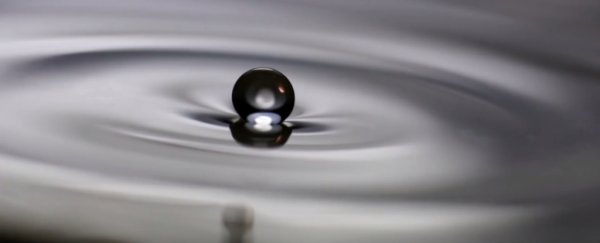Have you ever seen droplets skitter across a puddle on a rainy day, or when you pour milk into your coffee? Researchers have just found an explanation for why that happens under some conditions.
According to MIT scientists, to have a droplet float on the surface before combining with the rest of the liquid, temperature differences are key. And their latest research even shows how we can control this process.
Most of the time, liquid poured or dropped onto the same liquid will combine immediately, but sometimes you get droplets levitating on top. This counterintuitive phenomenon is called 'noncoalescence' - and it actually has a lot of uses in science.
Figuring out why droplets sometimes float can help develop better fluid emulsions, such as medicine, cosmetics and paint; and the phenomenon has potential applications in technologies such as microfluidic chips, where droplets could be used to carry reagents to specific locations, or as ball bearings in microgravity.
Noncoalescence, therefore, has been studied quite a bit, and researchers have been able to replicate it using several different techniques. Drops with opposite charges demonstrate noncoalescence, as does a vertically oscillating system.
Scientists also know that there are several factors that influence noncoalescence. Viscosity, surface tension, the height from which the droplet falls, electrostatic charge and droplet size can all play a role in whether the droplet forms, and how long it lasts before coalescing.
But more work is needed to understand why it happens and how to control it.
One possible mechanism is the idea that the surface of the liquid is lubricated by a thin film of air, or that there could be a layer of water in contact with the air that is structurally different from the liquid's bulk, in both the droplet and the body.
Meanwhile, a study in 1996 described the influence of temperature differences on the noncoalescence of liquids. Now a team of researchers from MIT, led by mechanical engineering graduate student Michela Geri, have conducted mathematical research of the temperature differences involved in this weird phenomenon.
"Based on our new theory, engineers can determine what is the initial critical temperature difference they need to maintain two drops separately, and what is the maximum weight that a bearing constructed from these levitating drops would be able to sustain," Geri said.
"If you have a fundamental understanding, you can start designing things the way you want them to work."
To conduct these experiments, Geri built a box with a metal floor, which she filled with silicone oil and placed on a hot-cold plate. She then used a syringe to deposit droplets of oil of the same viscosity into the bath, adjusting the temperature using the hot-cold plate.
The experiments were conducted across a range of temperatures, and a range of viscosities, from thin like water, to 500 times thicker. A high-speed camera recorded the experiments at 2,000 frames per second.
Geri found that the higher the temperature difference between the bath and the droplet, the higher the likelihood of noncoalescence. With a difference of 30 degrees Celsius (54 degrees Fahrenheit), she could maintain noncoalescence up to 10 seconds.
The amount of time the droplet lasted seemed to depend on the initial temperature difference, and that there's a critical temperature at which a droplet will form.
This is because the difference in temperature will create convection, or currents, in the small layer of air between the droplet and the surface. The higher the temperature, the stronger the currents.

The team also studied the relationship between the temperature difference and the amount of time a droplet rests on a surface.
"With a temperature difference, you generate a flow inside the drop, drawing up heat from the bath, which circulates around until the droplet temperature is the same as the bath and you don't levitate anymore," said study co-author, applied mathematician John Bush.
"We were able to describe that process mathematically."
According to Bush, scientists can now use this research to study how rain and ocean spray might spread chemical and biological agents.
"The rate at which these agents mix will depend on how long drops stay afloat before coalescing. Now we know that depends on temperature, and we can say exactly how."
The team's research has been published in the Journal of Fluid Mechanics.
